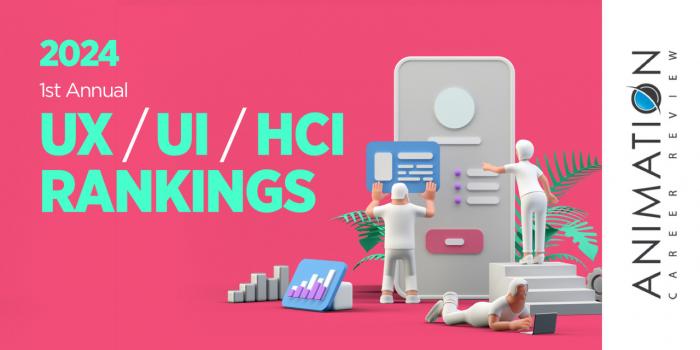
Did you know? The user experience (UX) design program at Savannah College of Art and Design was developed in collaboration with Google. Learn more.

| Ranking | School | State |
|---|---|---|
| 1 | Georgia Institute of Technology | Georgia |
| 2 | University of Central Florida | Florida |
| 3 | University of North Carolina at Chapel Hill | North Carolina |
| 4 | University of Miami | Florida |
| 5 | Elon University | North Carolina |
Our 2024 rankings of the Top 5 graduate UX/UI/HCI school programs in the South. For an explanation of ranking criteria, click here.

With 15,245 students, five schools, and 19 degree programs, the College of Computing at Georgia Institute of Technology (Georgia Tech) is one of the largest technology colleges in the U.S. Among the offerings here is an MS in Human-Computer Interaction (MS-HCI) that draws from four schools including Interactive Computing; Literature, Media, and Communication (LMC); Industrial Design; and Psychology.
This multidisciplinary program requires 36 credit hours, taken over four semesters. Regardless of the school, students will take the same fixed core courses. These include HCI Professional Preparation and Practice; Human-Computer Interaction Foundations; and Psychology Research Methods for HCI.
In addition, students will take courses related to their specialization, as well as electives across a wide range of areas such as Human-Robot Interaction; Human Factors; Technology Management; Computer Science, Industrial and Systems Engineering; and Cognitive Science. Specializations include Interactive Computing; Digital Media (DM, through the School of LMC); Industrial Design; and Psychology. With the exception of Psychology, all specializations provide numerous opportunities to immerse in HCI and related-coursework.
Across areas, students can choose from courses and electives such as Principles of User Interface Software; Human-Centered Computing; Interface Prototyping: Exploring Tools & Theories; Mixed Reality Experience Design; Human-Robot Interaction; Special Problems in Human-Computer Interaction; Prototyping Interactive Systems; Human-Centered Data Analysis; Service Design, Brand & Value Creation; Game Artificial Intelligence; Information Visualization; Physical Prototyping in HCI; Information and Communication Technologies and Global Development; Visualizing Communication for Interaction; Design of Interactive Environments; Discovery and Invention in Digital Media; Wearable Technologies for Health; Universal Design; and Web Design Accessibility.
In addition to access to in-demand courses, all Georgia Tech MS-HCI students have the opportunity to earn a Certificate in Technology Management from the College of Management. Students will also complete a mandatory internship during the summer after their first year of study.
Graduates of the MS-HCI program have been hired at companies across the U.S. and around the globe. Across programs, Georgia Tech alumni have been hired by companies such as Microsoft, Google, Boeing, Apple, IBM, Disney, Tesla, Intel, Cisco Systems, and Delta Airlines.
Georgia Institute of Technology was founded on October 13, 1885. The school opened in 1888, with 129 students enrolled in one degree program—the Mechanical Engineering BS. Today, Georgia Tech serves approximately 45,300 students from all 50 states and 149 countries.
More than 180 degree programs and minors are provided across six distinct colleges, 28 schools, and three campuses in Atlanta, Georgia (main); Georgia Tech-Lorraine in Metz, France; and Georgia Tech-Shenzhen in China. Georgia Institute of Technology is accredited by the Southern Association of Colleges and Schools Commission on Colleges (SACSCOC).

The College of Engineering and Computer Science at University of Central Florida (UCF) is home to the Department of Computer Science, which focuses on developing and evaluating interactive systems that enhance lives when utilizing computer-based environments. The Department also focuses on improving the user experience in areas such as medicine, education, robotics, entertainment, and general work productivity.
The Department of Computer Science at University of Central Florida also houses several labs and academies that allow students to collaborate, create, and conduct research across disciplines. This includes UX/UI/HCI.
The User Experience Academy (iUX Academy) partners students with local companies and organizations to provide UX services to clients allowing students gain real-world experience to prepare them for UX-related careers.
The Interactive Systems and User Experience Lab focuses on the development of innovative applications, techniques, and tools that enhance the overall experience between humans and machines.
The Synthetic Reality Lab known as SREAL is part of several larger UCF entities, most notably the Institute for Simulation & Training (IST), which houses it. SREAL (pronounced Surreal) is a center for researchers, software developers, artists (modelers/animators), interactors (digital puppeteers), PhD students, and affiliated faculty members. With 7,000 square feet of experimental and office space, SREAL houses areas for the development of AR/VR, mixed reality experiences, the delivery of interactive training using digital avatar technology, human surrogate and robotics research, and developing cultural heritage and STEM experiences.
Specific graduate degree programs for students interested in UX/UI/HCI include the Computer Science MS in the Department of Computer Science and the transdisciplinary Modeling and Simulation MS in the UCF School of Modeling, Simulation, and Training (SMST). MS in CS students can study Human-Computer Interaction through required electives and/or an approved research area. Human Computer- Interaction; Human-Centered Computing; Virtual Reality and HCI; User Interfaces; Information Visualization; Computer Graphics; and Machine Learning.
Modeling and Simulation MS students may specialize in areas such as Human Systems; Computer Visualization; or Interactive Simulation and Intelligent Systems. Students in this program may also take UX/UI/HCI-related coursework through a required 15 unrestricted electives. Examples include Human Computer Interaction; Experimental Design and Taguchi Methods; Human Factors; Interdisciplinary Approach to Data Visualization; Human Cognition and Learning; Computer Network Design; Digital Interaction for Informal Learning; and Advanced Computer Architecture.
Both programs provide opportunities to complete an internship and/or study abroad. The CS and SMST MS programs at University of Central Florida culminate with a Thesis or Research Project and Portfolio (for non-thesis students).
University of Central Florida MS graduates are prepared to pursue careers in UX/UI/HCI across industries. UCF CS and SMST alumni are routinely hired by major companies and organizations such as Amazon, Google, NASA, Apple, Lockheed Martin, IBM, Intel, Oracle, Cisco, Siemens, Accenture, and YouTube.
University of Central Florida opened in 1968 as Florida Technological University. On the first day of classes, the school had less than 2,000 students. Today, UCF serves around 70,400 students, making it the largest university by enrollment in the state of Florida, and one of the nation’s largest universities. The school provides 240 bachelor’s degrees, 214 master’s degrees, and 81 doctorate degrees across 13 colleges. University of Central Florida is accredited by the Southern Association of Colleges and Schools Commission on Colleges (SACSCOC).

University of North Carolina at Chapel Hill (UNC-Chapel Hill) houses the School of Information and Library Science (SILS), home to the MS in Information Science (MSIS). Accredited by the American Library Association (ALA) since 1934, the MSIS has a specialization in User Experience(UX)/Human-Computer Interaction the consists of courses such as Human Factors in Systems Design; User Interface Design; Usability Evaluation and Testing; Human Information Interactions; Information Visualization; Web Development; Visual Analytics; Social Media and Society; and Organization of Information.
Students will also take required MSIS courses such as Perspectives on Information, Technology, and People, and Ethics, Values and Society, as well as supporting courses such as Art and Visual Information Management; Information Analytics; Consumer Health Information; and Principles and Techniques of Storytelling.
In addition to a variety of multidisciplinary and UX/UI/HCI-related courses, MSIS students benefit from opportunities to gain professional experience through the Field Experience Program, which allows students to work for 135 hours for a company or organization under the supervision of an SILS faculty member and the site supervisor.
MSIS students at UNC-Chapel Hill also have access to a number of organizations and labs to support their goals. Examples include the Graphics and 3D Vision Laboratory, and the Graphics, Imaging, and Robotics Lab.
Housed in the Frederick P. Brooks Jr. Computer Science Building and Sitterson Hall, the new Graphics and 3D Vision Laboratory is situated in a noise-controlled, 2,500 sq. ft. space divided into three research zones by floor-to-ceiling blackout curtains for light and sound suppression. Zones include Projective Display Research, Computer Vision and Optical Tracking Research, and Physical Simulation and Audio Synthesis Research with a focus on GPU processing. The space has 11-foot ceilings and a Unistrut mounting grid.
The Graphics, Imaging, and Robotics Lab and the Graphics and 3D Vision Laboratory. The Graphics, Imaging, and Robotics Lab is a 3,500 sq. ft. space located in J. Carlyle Sitterson Hall. Most of the Lab is dedicated to work in effective virtual environments. The remaining area, which houses a variety of robots, focuses on robotics research.
The MSIS program at University of North Carolina at Chapel Hill culminates with a Capstone, which consists of a research-based master’s paper or a practicum/project. Students choice. Graduates are prepared for leadership roles in corporations and businesses across the healthcare and financial industries, at start-ups and within non-profit organizations, government agencies, and academic institutions. Areas include user interface design, user experience, human-computer interaction, emerging technologies, systems analysis and design, knowledge management systems, web design, social media, and instructional technologies, among others.
UNC-Chapel Hill alumni have gone on to establish careers at some of the world’s top corporations. Examples include Microsoft, Amazon, Accenture, Cisco, Capital One, SAS – Analytics Software & Solutions, and Red Ventures.
Founded in 1789, University of North Carolina at Chapel Hill welcomed its first students in 1795, becoming the first and only public university in the U.S. to award degrees in the 18th century. Today, UNC-Chapel Hill serves approximately 31,540 students enrolled in more than 250 bachelor’s, master’s, and doctoral degree programs across 14 colleges and schools. University of North Carolina at Chapel Hill is accredited by the Southern Association of Colleges and Schools Commission on Colleges (SACSCOC).

The School of Communication at University of Miami (UM) is home to the Department of Interactive Media, which houses a STEM-designated MFA program that focuses on design, technology, and human behavior. Areas explored include UI design, UX research, human-computer interaction, data visualization, social impact design, game design, wearables, mobile, VR, and other emerging technologies. Students in this multidisciplinary program are also encouraged to take advantage of focus areas such as User Experience, Data Visualization, and Game Design.
Course examples for the UM Interactive Media MFA include Prototyping; UX Research Methods; Human-Computer Interaction; Creative Coding; Human Centered Design; Innovation & Design; Technology Trends; Front-End Fundamentals; Augmented Reality; Designing Games for Impact; Immersive Storytelling; Design with AI; Wearable technologies; Physical Computing; and Dynamic Data.
Students in the Interactive Media MFA program at University of Miami have the opportunity to complete an internship, individual study, and project-based courses such as Game Development Studio. The program ends with a Final Presentation consisting of the Capstone. This culminating experience will be completed across two courses: Capstone 1 - Concept Incubation Studio, and Capstone 2 – Production Studio.
Graduates of the Interactive Media MFA program at University of Miami are prepared to pursue a variety of leadership roles across industries. Current alums are UX Designers, UX Researchers, Front-End Developers, Product Designers, Design Researchers, Graphic Designers, CIOs, and Web Developers. University of Miami alumni have been hired by companies such as Amazon, Google, Facebook, New York Times, GE, Expedia, the Washington Post, and Visa.
Chartered in 1925, University of Miami is a private research university with three campuses across Miami-Dade County including Coral Gables (main), the Leonard M. Miller School of Medicine campus near downtown Miami, and Rosenstiel School of Marine and Atmospheric Science, located on an 18-acre waterfront campus on Virginia Key in Biscayne Bay. The school serves more than 19,000 students enrolled in nearly 350 undergraduate majors, master’s, and doctoral programs across 12 colleges and schools. University of Miami is accredited by the Southern Association of Colleges and Schools Commission on Colleges (SACSCOC).

The School of Communications at Elon University is accredited by the Accrediting Council on Education in Journalism and Mass Communications (ACEJMC). Serving 1,400 students, the School of Communications provides six undergraduate majors and an Interactive Media MA. Thanks to this program, Elon is now one of only nine private institutions in the nation with an ACEJMC-accredited graduate communications program.
Designed to be completed in just 10 months, the Interactive MA begins with a two-week bootcamp, followed by courses that explore UX design, human-computer interaction, prototyping, usability testing, responsive web design, analytics, content development, social media, app development, and marketing.
Course examples include User Experience; Visual Aesthetics; Opportunities in Interactive Media; Front-End Development; Producing Interactive Media; and Interactive Media Theory and Research. Electives allow students to develop additional focused skills in a variety of areas. Elective examples include Application and Interface Design; Digital Brand Communications; Virtual Environments and the Metaverse; Game Design and Development; SEO, Analytics and Social Media Strategy; Multimedia Storytelling; and Intellectual Property Law.
Students may also complete a Professional Apprenticeship to help satisfy elective course requirements. In addition, 100% of Elon School of Communications students complete an internship.
Other Interactive Media MA program features include campus-based hands-on experiences; classes taught by published researchers and industry professionals; the opportunity to work on projects for real-world clients; personal mentoring and career guidance; individualized learning pathways; and summer Digital Media Workshops.
Students also have access to state-of-the art facilities designed specifically for the Interactive Media program. Facilities include high-tech graduate suites, editing suites, and a fibered control room; Mac and iMedia Innovation Labs; television studios; the latest graphic design, coding, and production techniques, including JavaScript for interactivity and data visualization; and a film screening theater.
The Interactive Media MA at Elon University requires a one week study away experience during the winter semester. This requirement consists of team projects at a domestic or international site. Students spend the week conducting interviews, and gathering audio, video, and photographs. When they return to campus, student teams will complete their Interactive Projects for the Public Good.
The program culminates in the spring semester with individual Interactive Media Capstone projects. Graduates are prepared to pursue leadership roles in UX/UI/HCI across all industries. Elon alumni have been recruited by companies such as Amazon, Bloomberg, Viacom, Deloitte, AT&T, Epic Games, PwC, Capital One, L’Oreal, ESPN, AstraZeneca, Citibank, TJX Companies, Boston Red Sox, Vanguard, Wells Fargo, KPMG, Bank of America, Amica, EY, Pfizer, Procter & Gamble, SAP, and Wayfair.
Founded in 1889, Elon University serves approximately 7,125 students from 49 states, DC, and 51 nations. The school provides more than 70 undergraduate majors, nine graduate programs, and a number of interdisciplinary programs across five schools and one college. Elon University is accredited by the Southern Association of Colleges and Schools Commission on Colleges (SACSCOC), and the National Association of Independent Colleges and Universities (NAICU).